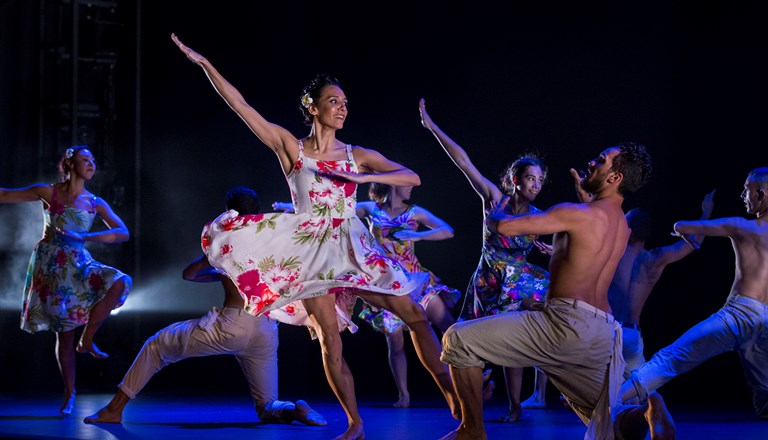I.B.I.S (2015)
Bringing the stories to the stage: the creative process
RESEARCH AND PREPARATION
Prior to working with the dancers in the studio, the choreographers and the designer Jake Nash, travelled to the Torres Strait (Thursday and Murray Island) in 2014, to spend time on country and in the community, to nourish their ideas, as well as talk with cultural consultants, William Satrick and Peggy Misi and work on a new ‘sit-down’ song on the language of Kala Lagaw Ya. Pinau Ghee and Aunty Betty Mabo also joined this stage of the process by coming down to Bangarra from Thursday Island to contribute stories and share knowledge. Both Misi and Ghee are former dancers with Bangarra so they had a keen understanding of the company’s creative processes. Ghee is also a manager of an IBIS store.
The cultural consultants provided the artists with an authentic essence of tradition as ideas emerged, and also facilitate the necessary permission and guidance in the making of a dance theatre piece that involves story, song and music inspired but he Islands and the communities that live there. The protocols that underpin this stage of the creative process are fundamental to the outcome of the work and are always a critical part of any new creation.
DANCE PRACTICE
I.B.I.S was created by the choreographers, in close collaboration with the dancers, the composer of the music, and the costume, set and lighting designers. The people who take on these roles form the creative team. The creative team collaborates closely during the entire creative process to enable the dance to reflect the overall focus of the choreographer’s ideas.
The choreographer, the rehearsal director and the dancers work together in the dance studio for many hours each day over several weeks to create the movement vocabulary and motifs for I.B.I.S. Together they invent movements that are inspired by the stories and the responses to being on country, developing their artistic interpretations to build dance sequences into a cohesive structure to the work.
DANCE SKILLS
Using their dance technique and performance skills, the dancers work to blend the movements and make them clear, and technically achievable, before eventually settling on a final version of the choreography.
The rehearsal director is present throughout this process in order to rehearse the dance, so that the key qualities and details of the choreography as set by the choreographer are retained and remembered. As the work moves closer to its premiere date, the rehearsal director works with the dancers for many hours to make sure they can perform the dance consistently at the highest standard possible. At this point in the process, the technical elements of the designers – costume, set, and lighting – start to be incorporated.
DANCE PRODUCTION PROCESSES
In the week of the premiere performance, the dancers, rehearsal director, creative team and production crew move from the Bangarra dance studios to the theatre where they spend many hours rigging the set, positioning and programming the lighting, checking the sound levels and making necessary adjustments to the choreography to fit the space of the stage. This is called the ‘bump in’ and the production crew is largely responsible for coordinating this stage of the process. There is much excitement during this bump in week because no one has actually seen the finished work. How the work looks in the theatre is always different to the way it looks in the studio.
There is often a media call on the day of the premiere where photographers take pictures of the dancers in dress rehearsal, and journalists conduct interviews with the creative team. On premiere night reviewers will attend to write about the work for their respective newspapers, websites and blogs. These reviews are usually published as soon as possible after the premiere.
THE LIFE OF A DANCE
During the lengthy process of creating a new Bangarra production, ideas will change and surprising shifts in the original plans will occur. This is the normal nature of the creative process, and probably one of the most exciting things about making a new work. Importantly, the elements that do not change are the traditional stories and original cultural elements, which always remain respected and intact. As the dance is performed over time, the story is passed from one dancer’s body to another as different dancers are taught the choreography.

